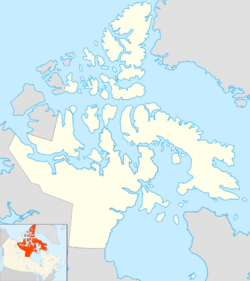Beechey Island facts for kids
|
Native name:
Iluvialuit
|
|
|---|---|
|
Location in the Canadian Arctic Archipelago
|
|
| Geography | |
| Location | Northern Canada |
| Coordinates | 74°43′N 091°51′W / 74.717°N 91.850°W |
| Archipelago | Queen Elizabeth Islands Canadian Arctic Archipelago |
| Area | 4.6 km2 (1.8 sq mi) |
| Highest elevation | 198 m (650 ft) |
| Highest point | Un-named |
| Administration | |
|
Canada
|
|
| Territory | Nunavut |
| Demographics | |
| Population | Uninhabited |
| Official name: Beechey Island Sites National Historic Sites of Canada | |
| Designated: | 1993 |
Beechey Island (Inuktitut: Iluvialuit) is a small island in Nunavut, Canada. It's part of the Canadian Arctic Archipelago, a group of islands in the far north. The island sits in the Wellington Channel, near the southwest tip of Devon Island. It's famous for its important role in Arctic exploration history.
Contents
Exploring Beechey Island's Past
The first Europeans visited Beechey Island in 1819. This visit was led by William Edward Parry, a brave captain. The island was named after an artist, William Beechey. His son, Frederick William Beechey, was part of Parry's crew.
Beechey Island is very important for understanding Arctic exploration. In 1845, a British explorer named Sir John Franklin chose this island. He set up his first winter camp here. Franklin was trying to find the Northwest Passage with his ships, HMS Erebus and HMS Terror. Sadly, his expedition was lost.
Other explorers also used the island. In 1850, Edward Belcher made it his base. Many memorials to Franklin and other explorers are found on the island. These include a memorial for Joseph René Bellot.
In 1903, the famous Norwegian explorer Roald Amundsen visited Beechey Island. He stopped there at the start of his successful journey. Amundsen was the first to sail all the way through the Northwest Passage.
A Special Historic Place
In 1975, Beechey Island was made a Territorial Historic Site. This was done by the government of the Northwest Territories. Since 1999, the island has been part of Nunavut, Canada's newest territory.
In 1993, several places on Beechey Island became a National Historic Site of Canada. These sites include Franklin's winter camp from 1845–46. They also include Northumberland House and other important spots.
The Graves of Franklin's Crew
Beechey Island is well-known because it holds three graves. These graves belong to members of the Franklin expedition. Searchers looking for Franklin's lost ships found them in 1850.
The searchers found a large stone pile, called a cairn. They also found the graves of three crewmen. These were John Torrington, William Braine, and John Hartnell. There was no message left behind to say where Franklin planned to go next.
In 1852, another explorer, Commander Edward A. Inglefield, arrived. A doctor with him, Dr. Peter Sutherland, opened John Hartnell's grave. This damaged his coffin. Later, in 1854, another searcher named Thomas Morgan died. He was buried next to the three original crew members.
In the 1980s, scientists studied the three bodies. A Canadian scientist named Dr. Owen Beattie examined them. He found the bodies were very well-preserved. Tests showed that lung disease and lead poisoning might have caused their deaths. The lead may have come from the food cans used on the expedition.
Later studies suggested that the lead levels were high. However, they were similar to lead levels found in other people from the 1800s. This means the lead might have come from everyday life back then. It might not have been the only reason for their deaths.
In the 1990s, the grave markers on Beechey Island were getting old. So, new markers made of bronze were put in their place.
Beechey Island in Stories
Beechey Island has appeared in many books. In Jules Verne's novel The Adventures of Captain Hatteras, explorers visit the island. Clive Cussler's book, Arctic Drift, also features characters who go to Beechey Island. The island is also mentioned in Dan Simmons' novel, The Terror.
Images for kids
-
(L-R) The Franklin Camp graves of John Torrington, William Braine, John Hartnell and Thomas Morgan.
See also
 In Spanish: Isla Beechey para niños
In Spanish: Isla Beechey para niños






